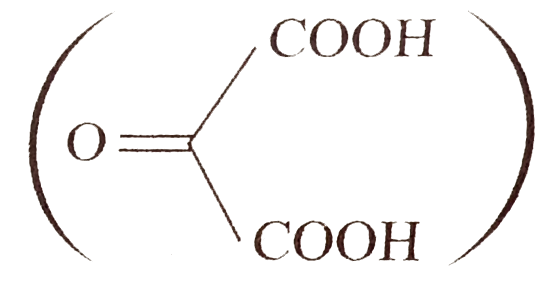A hydrocarbon C6H12 decolourises bromine solution and yields n−hexane on hydrogenation. On oxidation with KMnO4 it affords two different monobasic acids of the type R−COOH. The compound is :
Cyclohexene
2-Hexene
1-Hexene
3-Hexene
The correct Answer is:D
1D.U suggests alkene (decolourises Br2 solution), gives n−hexane on hydrogenation. Two different acids on oxidation suggest that (C=C) bond is not symmetrical. So, the compound (A) is :
 .
.
Topper's Solved these Questions
- BOOK - CENGAGE CHEMISTRYCHAPTER - CARBOXYLIC ACIDS AND THEIR DERIVATIVESEXERCISE - Exercises (Assertion-Reasoning)10videos
CARBOXYLIC ACIDS AND THEIR DERIVATIVES
- BOOK - CENGAGE CHEMISTRYCHAPTER - CARBOXYLIC ACIDS AND THEIR DERIVATIVESEXERCISE - Exercises Archives (Single Correct)10videos
CARBOXYLIC ACIDS AND THEIR DERIVATIVES
- BOOK - CENGAGE CHEMISTRYCHAPTER - CARBOXYLIC ACIDS AND THEIR DERIVATIVESEXERCISE - Exercises (Multiple Correct)35videos
CARBOXYLIC ACIDS AND THEIR DERIVATIVES
- BOOK - CENGAGE CHEMISTRYCHAPTER - BIOMOLECULES, POLYMERS AND CHEMISTRY IN EVERYDAY LIFEEXERCISE - QUESTION BANK8videos
BIOMOLECULES, POLYMERS AND CHEMISTRY IN EVERYDAY LIFE
- BOOK - CENGAGE CHEMISTRYCHAPTER - CHEMICAL KINETICSEXERCISE - Archives Subjective23videos
CHEMICAL KINETICS
Similar Questions
An organic compound (A) with molecular formula C8H8O forms an orange red precipitate with 2,4 -DNP reagent and gives yellow precipitate on heating with iodine in the presence of sodium hydroxide . It neither reduces Tollen's reagent or Fehling's solution , nor does it decolourise bromine water or Baeyer's reagent. On drastic oxidation with chromic acid, it gives a carboxylic acid (B) having molecular formulae C7H6O2. Identify the compound (A) and (B) and explain the reactions involved .
View SolutionCompound (A)(C12H16) on oxidation with acideic KMnO4 solution gives acetone and
 . Identify compound (A). View Solution
. Identify compound (A). View Solution
Knowledge Check
- Question 1 - Select One
A hydrocarbon of formula C6H12 decolourises bromine water. It also gives precipatate with ammonical AgNO3 solution. The hydrocarbon is
A1,3,5-CyclohexatrieneB1,5-HexadiyneC2,4-HexadiyneDNone of these - Question 2 - Select One
A hydrocarbon, ‘X’(C3H4) decolourise bromine in carbon tetrachloride forming ‘Y’ . ‘X’ gave a red precipitate of a compound ‘Z’ with ammonical cuprous chloride and formed a carbonyl compound with dilute sulphuric acid in the presence of Hg+2 ions. X, Y, and Z are given by the set -
ACH2=C=CH2,CH2Br–CBr2–CH2Br,CH3–C≡C–CuBCH3–C≡CH,CH3–CBr2–CHBr2,CH3–C≡C–CuCCH3–C≡CH,CH3–CBr=CHBr,CH2Cu–C≡CHDCH2=C=CH2,CH2Br–CH=CHBr,CH3–C≡C–Cu - Question 3 - Select One
A hydrocarbon of molecular formula C4H6 decolourises bromine water and gives white ppt with Tollens reagent. This hydrocarbon on hydration gives butanone. The hydrocarbon is :
A1, 3 - butadieneBCyclobuteneC1 - butyneD2 - butyne
The hydrocarbon [A] adds one mole of hydrogen in the presence of a platinum catalyst to form n-hexane. When [A] is oxidised vigorously with KMnO4, a single carboxylic acid containing three carbon atoms is isolated. Give the strucure of [A] and explain the reactions.
View SolutionA hydrocarbon (X), C6H12 ,on catalytic hydrogenation gives "n" - hexane."(X)" on addition "HBr" forms only single bromo compound."(X)" is :
View SolutionA compound soluble in conc. H2SO4. It does not decolourise bromine in CCl4 but oxidised by chromic anhydride in aqueous H2SO4 within two seconds, turning organs solution to blue, green and then opaque. The original compound is :
View SolutionA hgydrocarbon X adds on one mole of hydrogen to gives another hydrocarbon and also decolourises bromine water.X reacts with KMnO4 in presenece of acid to give two moles of the same carboxylic acid.The structure of X is:
View SolutionA hydrocarbon C8H16 on oxidation with a hot adidified solution of KMnO4 forms butanone and isobutyric acid. The hydrocarbon is
View Solution

